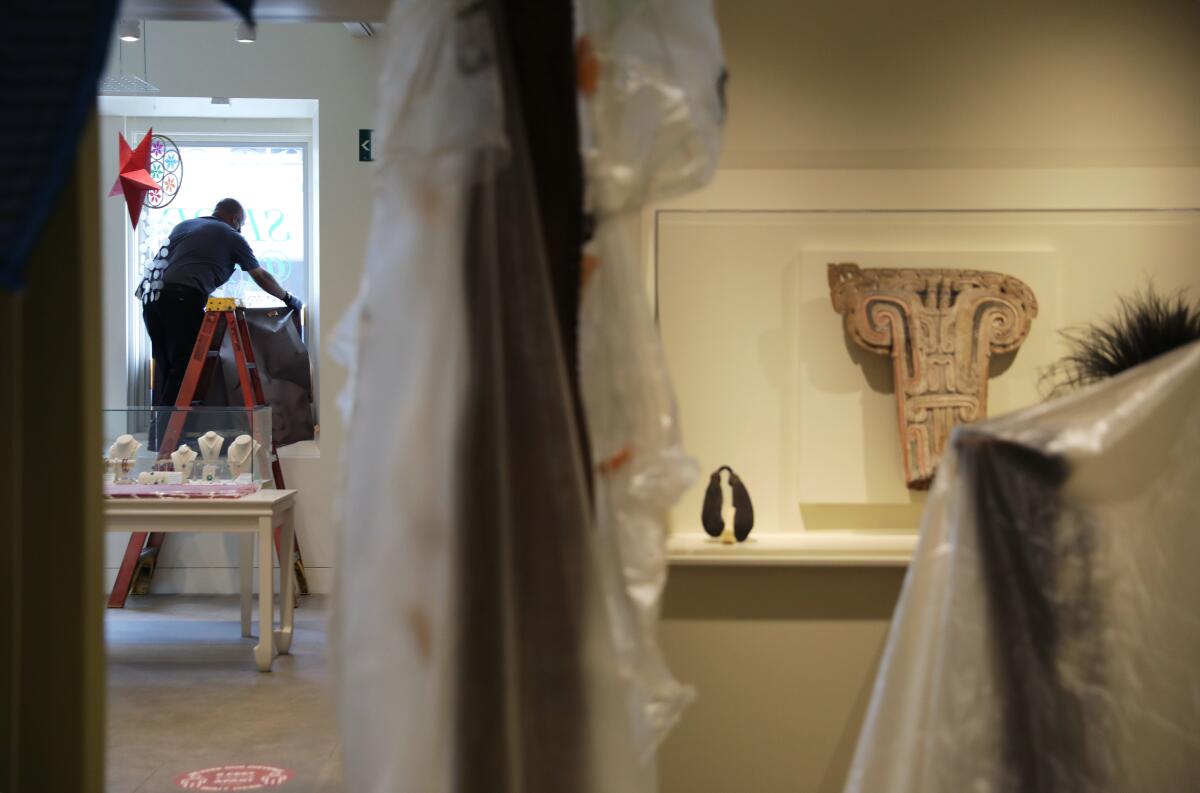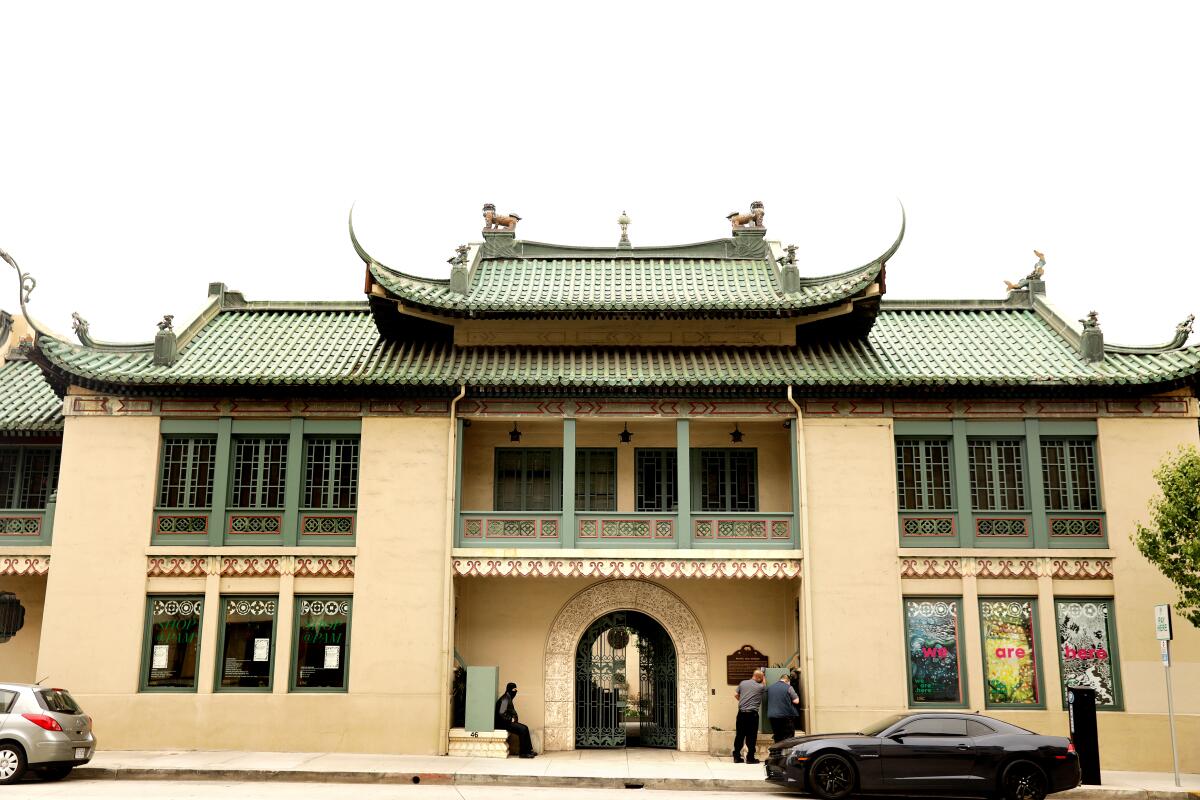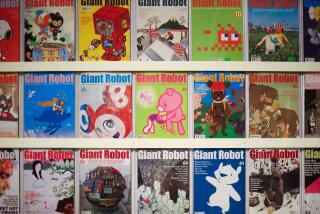USC Pacific Asia in Pasadena reopens with a new goal: Decolonize our own museum

- Share via
As the COVID-19 pandemic hit and the world spiraled into shutdown last year, a disturbing trend caught the attention of Bethany Montagano, director of the USC Pacific Asia Museum in Pasadena, and her staff. “We had a ‘Mulan’ movie poster on a bus stop outside the museum,” she said, “and on it was written in graffiti: ‘kung flu canceled.’”
The phrase made a link between COVID-19 and China, articulating what some people were wishing for both. The pandemic did prompt Disney to scuttle the movie’s theatrical release, and the hostility expressed in such close proximity to the museum alarmed staffers. As part of USC, they knew Asian students who were afraid to go out in public, even to visit the grocery store.
“It was an impetus for us to launch a new initiative,” said Montagano, referring to the Pacific Asia Museum’s announcement last fall that is was setting out “to deconstruct Orientalism through collections management, exhibitions and programming.“
“We felt a sense of urgency to do this because colonial systems of oppression were really rearing their ugly head in the wake of COVID,” she said, “especially as it relates to Asian Americans and the colonial brand of poison projected onto Asian Americans.” Tragically, the March killings of six women of Asian descent in Atlanta and the increased acts of violence against Asian Americans nationwide have only added to the urgency.

In two Zoom conversations, Montagano outlined efforts to rethink and reprogram the museum, which reopens from its pandemic shutdown on Saturday. For starters, the museum is reviewing the 15,000 objects in its collection. Curator Rebecca Hall, in collaboration with scholars and community advisors, is examining how they are classified and asking if there are inherent biases in how they are described or categorized. For example, the museum’s collection of prints by Paul Jacoulet — a Frenchman raised in early 20th century Japan whose work tended to exoticize Asian cultures — may in the future be classified as part of an education collection for use by USC faculty.
Another task is to study provenance, the history of where objects came from and how they were acquired and transferred. This question plagues Asian antiquities held in foreign museums since many objects were taken out of their countries of origin before antiquities laws were enacted or enforced, or were simply stolen from historical or sacred sites.
The Getty Center and the Broad museum are open! Here is our May guide to the most promising exhibitions across Southern California.
In 2008 the Pacific Asia Museum was among four Southern California museums raided during a federal investigation into illegally exported Asian antiquities; the Bowers Museum in Santa Ana and the Mingei International Museum in San Diego later returned more than 600 objects to Thailand. A Pacific Asia spokesperson said the disputed objects in the Pasadena museum’s collection were “seized in place,” and to this day they remain awaiting the FBI to provide details for repatriation.
Montagano acknowledged that the Pacific Asia Museum has “objects that were obtained through colonial appropriation. We have heads upon heads in our collection. Those statue heads and temple remnants belong to things that are in Southeast Asia, right?”
She said the museum was working with researchers and making the collection available online “to help us in this project of hopefully finding a connection, so we could potentially make a match.” When asked whether the museum would automatically return objects if matches were found, Montagano said the institution would have a public discussion and bring in the community to decide what to do. “That’s how we decolonize our practices,” she said. “By sharing power, by letting other people in.”
As museum staffers are reviewing how to present their permanent collection, they also want to refocus their temporary shows, regularly bringing in contemporary subject matter. The museum was built on Asian art typically collected by Westerners in the 20th century (think Chinese ceramics from the Neolithic to the Qing dynasties and Japanese prints from the Edo period), but it also was the among the first American museums to mount a contemporary Chinese art exhibition, “Beyond the Open Door: Contemporary Paintings From the People’s Republic of China,” in 1987.
Today it’s committed to moving exhibitions away from stereotypes and toward a wider, more complex view of Asian culture and identity. The current exhibition, “We Are Here: Contemporary Art and Asian Voices in Los Angeles,” which opened just a couple of days before the pandemic closed it, features seven female artists of Asian descent.
“The Asian experience and the Asian American experience is so flattened by the way we typically talk about it,” said Hall, who organized the show. “As a curator, I know artists can fill that out in a rich way.”
She looked for Asian artists living or working in Los Angeles and found that the work she was especially drawn to were by female artists. For her, it was important that “all of the artwork is rooted in the artist’s experience.”
Ahree Lee exemplifies the range of media and subject matter in the show. Working in video, new media and textiles, Lee creates art that looks abstract but becomes decipherable when you look more closely or understand the code embedded within the pieces.
Lee was born in Seoul and came to the U.S. as an infant with her family. She graduated from Yale with a bachelor’s degree in English literature and earned an MFA in graphic design from Yale School of Art. During a project at the Asian Art Museum in San Francisco, Lee discovered a collection of bojagi, or Korean cloths made through quilting together remnants. In her video “Bojagi (Memories to Light),” she pieces together vintage home movies from Asian American families into quilt-like patterns through computer graphics. Put into motion, they look like kaleidoscopes.
A kids’ dance event, “Dunkirk” in 70mm, Discovery Cube reopening, Zombie Joe’s, L.A. Dance Project and more. Here’s our short list.
“It does draw on part of my identity as someone who used to work in Silicon Valley and who continues to work with technology,” Lee said. “I’m equally drawn to the arts and liberal arts, and also to sciences and math — two different approaches to things, not given equal weight in society and often assigned to different genders.”
Also in the exhibition are small textile panels Lee made on a loom, part of her “Pattern: Code” series. In the most complex piece, “Timesheet,” she tried to convey her daily life through pattern and weaving. “I’ve always been fascinated with learning more about myself and tracking myself,” she said. For this project she recorded hour by hour what she did every day for a week, putting the activities into eight categories, such as child care, housework and art. She then rendered the chart into a woven grid.
She was surprised by how much time she spent on food — shopping for it, preparing it, cleaning up after meals.
“The other thing I learned is that the categories are kind of slippery,” she said. “When you’re working at home, there are a lot more layers to work. So I’m on the computer working and also minding my daughter while she’s on Zoom in her school.”
Another artist in the exhibition, Kaoru Mansour, is a painter and collage artist who often depicts human figures and flora, while her compositions incorporate what might be considered a traditional Japanese aesthetic of negative space.
Mansour was born in rural Japan and came to the U.S. as an adult. While she doesn’t consciously try to insert autobiography in her work, her mixed-media painting on canvas “Candy and Rain” does use old photographs from her family. On the lower right are two girls, herself and her childhood pal, and on the upper left stands an older gentleman in a formal morning suit, a man who is her great-uncle.
“Just my instinct,” she said, “I saw the shape of those two girls as abstract shapes, and I reacted to the shape, the mood of my great uncle.” Then she admits that the male figure may seem “very strict,” and “if you go far enough in the story that time [Japan] was still a very chauvinistic country.” This is part of a series of work in which she uses old photographs to look back to the past, she said, a series prompted by her father’s loss of memory from Alzheimer’s.
Most of her paintings reflect her penchant for abstract imagery, and she doesn’t think about her gender or cultural identity when working on them. “However, how I use spaces might be very Japanese, and my artist friends say that too,” she said. The use of negative space is evident in “Candy and Rain” in which the figures stand against flat backgrounds, with the girls standing atop a cluster of colored circles and the man over a cut-out shape that looks like a puzzle piece. In the painting on panel “Fuji(mame)” (“Wisteria Pods”) a continuous vine of wisteria is organized horizontally, again on a flat background.
Hall saw “We Are Here” as a benchmark in the museum’s history.
“It’s an exhibition which has helped shape and shift our future,” she said. “I love the diversity of our Asian communities, and I wanted to find a way to embrace that on our museum walls.”
Upcoming exhibitions at the museum will include a Nick Dong installation that incorporates themes of Buddhist spirituality and healing. For a 50th anniversary show in the fall, “Intervention: Perspectives for a New PAM,” artists and scholars will reflect on the museum’s history and collection.
'We Are Here: Contemporary Art and Asian Voices in Los Angeles'
Where: USC Pacific Asia Museum, 46 N. Los Robles Ave., Pasadena
When: 11 a.m.-5 p.m. Wednesdays-Sundays; closes June 6
Admission: Pay what you wish through June 6. Afterward, $7-$10; students and children 17 and younger are free. Reservations required; face coverings with no vents mandatory for all visitors 2 and older
Info: (626) 787-2680, pacificasiamuseum.usc.edu
After a year of racial reckoning, an L.A. Times survey shows the quest for equity at museums, theaters and music companies has a long way to go.
More to Read
The biggest entertainment stories
Get our big stories about Hollywood, film, television, music, arts, culture and more right in your inbox as soon as they publish.
You may occasionally receive promotional content from the Los Angeles Times.











